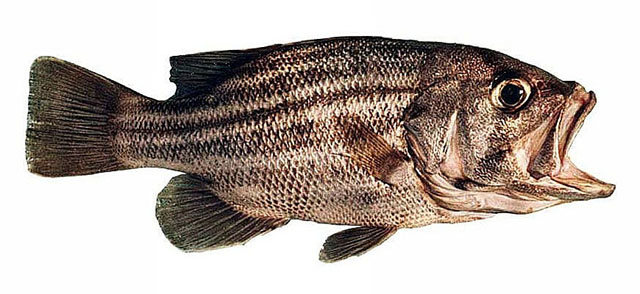| Glaucosomatidae (Pearl perches) |
| 122 cm TL (male/unsexed); max.weight: 26 kg |
|
reef-associated; marine; depth range 1 - 200 m, non-migratory |
| Eastern Indian Ocean: endemic to Australian waters. Distributed from the Recherche Archipelago off Esperance, to Beagle Island, although they are rare north of Shark Bay. Records from Japan (Ref. 559, 12517) and Taiwan (Ref. 5193) are Glaucosoma buergeri (Ref. 27621). |
|
Dorsal spines (total): 8-8; Dorsal soft rays (total): 11-11; Anal spines: 3-3; Anal soft rays: 9-9. One dark vertical band through eye which may disappear with an increase in size; 11 dorsal fin rays and 9 anal fin rays. Supraclavicle not developed into a bony shield. Peritoneum and gill rakers pale; lateral line with 44 to 48 pored scales; juveniles with wide dark horizontal bands wider than interspaces. |
| Westralian jewfish live in shallow inshore waters and depths to over 200 m (Ref. 27560). They are present over hard, flat sea beds (e.g. limestone shelf) and in reefs, wrecks and underwater caverns and gutters. Adult fish move into shallower waters in the cooler months between April and June (Ref. 27560, 27561). Juveniles tend to remain in shallower water than adults and are rarely found in waters more than 100 m deep (Ref. 27560). Adults feed mainly on fish, also rock lobsters, crabs, squid, octopus and cuttlefish. Marketed as fresh fish (Ref. 10384). |
|
Not Evaluated (N.E.) Ref. (130435)
|
| harmless |
|
Endemic to Australian waters, and are present only in Western Australia. They inhabit waters from the Recherche Archipelago off Esperance, to Beagle Island, although they are rare north of Shark Bay. Also Ref. 43239.
Commercial fishery: Westralian jewfish are taken commercially off the Western Australian coast from Bremer Bay to Shark Bay, with the majority of the catch coming from the waters of the mid-west coast, off Geraldton. The main methods of capture are bottom set gillnets, droplines, bottom set longlines and handlines. The greatest part of the catch is taken by handline, with peak catches generally occurring between December and February, coinciding with the spawning season. Westralian jewfish are taken in gillnets and on longlines as bycatch of the Southwest Shark Fishery.
Westralian jewfish are sold whole, or gilled and gutted.
Recreational fishery: Westralian jewfish are taken by recreational fishers throughout their range and heaviest fishing effort centres on offshore reefs along the southern and southwestern coasts (Ref. 27560). The recreational Westralian jewfish catch is estimated to be greater than the commercial catch. They are fished throughout the year and their habit of migrating inshore in the cooler months makes larger fish more accessible (Ref. 27560, 27561).
Experienced anglers suggest that the most productive time to fish for Westralian jewfish is late afternoon, through the night, and early in the morning. The main method used is boat-based handlining, either with the boat drifting, or by anchoring and berleying (Ref. 27560).
Westralian jewfish rank with snapper (Pagrus auratus) as the fifth most popular fish targeted by anglers, and they are the most prized demersal species (Ref. 27560). The largest Westralian jewfish caught by a recreational fisher was 25.9 kg (records of the Australian Anglers Association).
Resource status: The status of the resource is unknown. There is some evidence of increased fishing pressure in certain areas, where there has been a decrease in the average size of Westralian jewfish taken by anglers (Ref. 27560). The stock may be in danger of overfishing (Ref. 27621). |
Source and more info: www.fishbase.org. For personal, classroom, and other internal use only. Not for publication.

